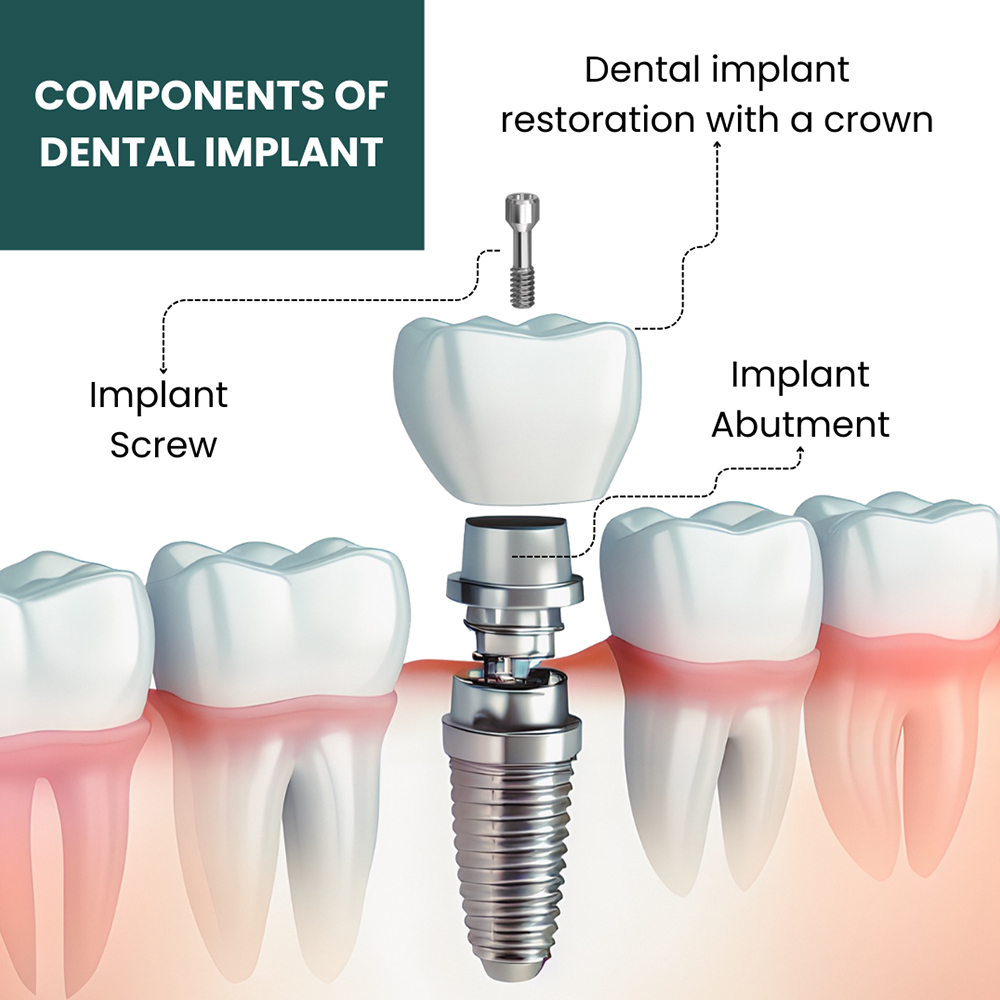About Dental Implants
Table of ContentsThe 30-Second Trick For Dental ImplantsThe Basic Principles Of Dental Implants The smart Trick of Dental Implants That Nobody is DiscussingDental Implants Things To Know Before You Get This
are medical gadgets surgically dental implanted into the jaw to restore a person's capability to eat or their appearance. They supply support for synthetic (phony) teeth, such as crowns, bridges, or dentures. When a tooth is shed due to injury or illness, an individual can experience complications such as fast bone loss, malfunctioning speech, or adjustments to chewing patterns that result in discomfort.
Framework of The Dental Implant System picking dental implants, talk with your dental supplier about the possible benefits and threats, and whether you are a candidate for the treatment. Points to consider: Your total wellness is a crucial consider determining whether you are a good candidate for oral implants, the length of time it will require to recover, and how much time the implant might remain in place.
Smoking may impact the healing procedure and reduce the long-term success of the dental implant. The recovery process for the implant body might take several months or longer, throughout which time you generally have a short-lived abutment in location of the tooth. the oral implant procedure: Very carefully adhere to the oral hygiene guidelines given to you by your dental provider.
More About Dental Implants
Implant failing can result in the need for another surgical procedure to repair or change the dental implant system. Brings back the capacity to eat Recovers cosmetic appearance Assists keep the jawbone from shrinking due to bone loss Maintains the health and wellness of the surrounding bone and gum tissues Aids maintain nearby (close-by) teeth steady Enhances lifestyle Damage to surrounding natural teeth throughout dental implant placement Injury to the surrounding tissues during surgical treatment, such as sinus perforation Injury during surgery (for instance, crack of surrounding jawbone) Insufficient function, such as seeming like the teeth do not attack with each other typically A sensation that the tooth is loosened or turning in position resulting from a joint screw loosening Implant body failure (looseness of the dental implant body) because of systemic infection, which may be more most likely in people with unrestrained diabetics issues due to local infection in bone and gum tissues sustaining the dental implant body due to postponed recovery, which may be more probable in clients who smoke Trouble cleaning up the gums around the implant, resulting in you can try these out inadequate oral health Untreated gum condition Post-surgical tingling because of nerve impingement or damage Constantly inform healthcare companies and imaging service technicians that you have oral implants before any magnetic resonance imaging (MRI) or x-ray procedures.
FDA is not knowledgeable about any negative events reported for MRI or x-ray procedures with that site oral implants. Dental implants systems are typically constructed from materials that follow global agreement requirements of the International Organization for Standardization (ISO) or ASTM International. These standards have information of what makes a safe product.
Other products such as gold alloys, cobalt-based alloys, titanium alloys, or ceramic products are sometimes made use of. The security accounts of these materials are well-known. Dental dental implant systems are reviewed according to international agreement standards. Biocompatibility screening, to reveal that bodily call with the gadget does not create problems like irritation or allergy, becomes part of the assessment that helps guarantee the products in the oral implant system are secure and do not trigger unfavorable impacts when dental implanted in individuals.

Get This Report on Dental Implants
Some individuals are not qualified for oral implant surgery. It is for dental cosmetic surgeons to operate on people with: severe illnessuncontrollable metabolic diseasebone or soft tissue illness or infectionIf these concerns are resolved, a person can have the surgery. Dental Implants. In, dental cosmetic surgeons abstain from running on individuals with: If individuals with any of the above undergo dental implant surgical treatment, there is a higher risk of why not try this out the implant falling short
Some people have a jawbone abnormality that avoids enough bone for an implant from developing. The doctor will certainly then make use of a bone or bone alternative to repair and develop up the location.
Dental implant surgical treatment is a personalized process. It's not the very same for everyone. The following offers a general overview of what you can anticipate your dentist, oral cosmetic surgeon, periodontist or prosthodontist to do: Position the implant operatively. Give you time to heal. Affix the message and last crown, bridge or denture.
Next, your doctor will thoroughly put the oral implant into your jaw. Ultimately, your cosmetic surgeon will certainly reposition your gum tissues and close the laceration with stitches. If your dental implant is near the front of your mouth, your dental professional will make a temporary tooth for you to wear until you heal. By doing this, you won't have a space in your smile while you recuperate.
The Best Strategy To Use For Dental Implants
Your provider can tell you what to anticipate in your situation. During the healing phase, your jawbone ought to fuse to the oral implant. This process, called osseointegration, is critical for security and long-lasting success. This process can take anywhere from three to 9 months. Sometimes, it might take longer.
When your implant heals, your dental practitioner can affix the joint (little connector article) and your final reconstruction (crown, bridge or denture). This usually takes about one hour to complete and may call for a second small surgery. You shouldn't feel any type of discomfort throughout your dental implant procedure because your company will utilize medication to numb your gum tissues.